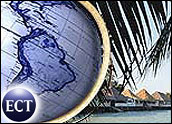
As the Web becomes an increasingly global marketplace, U.S. based companies will need to create multicultural, multilingual Web sites in order to compete, according to a report released Thursday by Aberdeen Group.
The report, “Web Globalization: Write Once, Deploy Worldwide,” found that some big companies are already taking steps to “globalize” their Web sites. For example, the number of U.S. Fortune 100 companies with multilingual Web sites jumped from 33 during 1999 to 57 by the end of 2000.
Companies that do not globalize their Web sites are “missing a fairly large-sized business opportunity,” Aberdeen managing director Thomas L. Dwyer told the E-Commerce Times.
According to Aberdeen, creating a multilingual Web presence is likely to extend a company’s market reach at a low cost.
Wide Net
At the end of last year, 52 percent of the online population was non-English speaking, according to the report. In the next two years, Aberdeen said, that number will likely increase to 68 percent.
Aberdeen is also predicting that 66 percent of all e-commerce spending will be outside of the U.S. within the next two years.
“New Web users in Latin America, the Middle East, and Asia/Pacific are putting U.S.-based, English-speaking Web users in the minority,” Dwyer said.
“Web globalization will remove geography from the competitive equation,” he added. “It enables Web buyers to select products and services based on the relevance, appeal, and comfort level of a supplier’s Web site, whether it’s the local Wal-Mart or the Carrefour on another continent.”
Dwyer pointed out that as consumers become more comfortable buying online, the amount of international competition would put increasing pressure on U.S. companies.
Sales Boost
Dwyer said that increased sales would be the first wave of benefits realized by globalizing, and cost savings would be the second.
On average, Web surfers stay on a site two times longer if the content is available in their native language, according to Dwyer. Additionally, consumers are four times more likely to buy something from a native language Web site, because it is easier for them to thoroughly research the product and the company.
Buyers are also more likely to return an item if the Web site is not optimized for international transactions. Aberdeen found that the return rate for products sold internationally is a staggering 46 percent.
Cost Savings
Companies will also realize tremendous cost savings from globalizing their Web sites and making them more easier for international consumers to use without assistance, according to Aberdeen.
Dwyer said that companies spend US$30 to $60 dollars on each customer service call they receive. However, costs for each Web visit are under $1.
If companies offer consumers the chance to view important information — including frequently asked questions (FAQs) and account status data — in their native language, consumers are less likely to make costly customer service calls, the report said.
Aberdeen predicted that in the next three years, 80 percent of multinational business-to-business (B2B) companies will be multilingual and business-to-consumer (B2C) sites could achieve that rate of globalization within two years.
Translation Please
IBM has been taking steps of late to take advantage of the need for globalized Web sites. For example, in January, the high-tech giant released an updated version of its Webshere software, designed to lower the financial and communication hurdles of international e-commerce sales.
The updated software, which is available in 10 languages, includes region-specific sales tax and shipping rules, customized product catalogs and localized payment methods and pricing, IBM said.
The new version of WebSphere lets companies manage pages written in multiple languages from a single e-commerce site, and lets users switch back and forth between different languages, according to Kevin Doyle, product marketing manager for IBM’s WebSphere Commerce Suite. ![]()
















































Social Media
See all Social Media